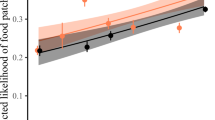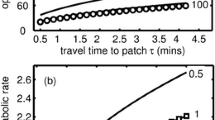Summary
A controversy exists over the relative roles of feeding enhancement and predation in shaping the flocking behavior of birds. We examined social attraction among foraging Sandwich Terns, Sterna sandvicensis, in the Gulf of Mexico. The prediction that foraging terns would coalesce at a spot where another bird dove was supported. Approach took place within seconds, occurred over a distance of at least 500 m, and lasted about 10 to 20 s after the food source dissipated. Although social attraction appears to play a major role in the feeding of the terns, this need not be construed as evidence against a similarly important role for predation in shaping social foraging behavior.
Similar content being viewed by others
References
Armstrong EA (1946) The colouration of sea-birds. Birds Br 2:15–19
Ashmole NP, Ashmole MJ (1967) Comparative feeding ecology of sea birds of a tropical oceanic island. Bull Peabody Mus Nat Hist 24:1–131
Burger J, Gochfeld M (1981) Age-related differences in piracy behaviour of Larus gulls. Behaviour 77:242–267
Cowan PJ (1972) The contrast and colouration of seabirds; an experimental approach. Ibis 114:390–393
Feare CJ (1967) Feeding enhancement in the family Laridae. Seabird 3:45–46
Gochfeld M (1978) Intraspecific social stimulation and temporal avoidance of songs of the Lesser Skylark. Z Tierpsychol 48:337–344
Gochfeld M, Burger J (1981) Age-related differences in piracy of frigatebirds from Laughing Gulls. Condor 83:79–82
Konig C (1974) Zum Verhalten spanischer Geier an Kadavern. J Ornithol 115:289–320
Krebs JR, Macroberts MH, Cullen JM (1972) Flocking and feeding in the Great Tit Parus major — an experimental study. Ibis 114:507–530
Kushlan J (1977) The significance of plumage colour in the formation of feeding aggregations of Ciconiiforms. Ibis 119:361–364
Lazarus J (1972) Natural selection and the functions of flocking in birds: a reply to Murton. Ibis 114:556–558
Murton RK (1971) Polymorphism in Ardeidae. Ibis 113:97–99
Simmons KEL (1972) Some adaptive features of seabird plumage types. Br Birds 65:466–479, 510–521
Veen J (1977) Functional and causal aspects of nest distribution in colonies of the Sandwich Tern. Behaviour (Suppl) 20:1–193
Ward P, Zahavi A (1973) The importance of certain assemblages of birds as ‘information centres’ for food-finding. Ibis 115:517–534
Author information
Authors and Affiliations
Rights and permissions
About this article
Cite this article
Gochfeld, M., Burger, J. Feeding enhancement by social attraction in the Sandwich Tern. Behav Ecol Sociobiol 10, 15–17 (1982). https://doi.org/10.1007/BF00296391
Received:
Accepted:
Issue Date:
DOI: https://doi.org/10.1007/BF00296391




